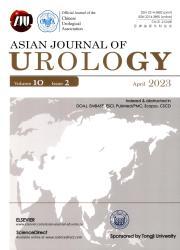Single bladder instillation of gemcitabine versus mitomycin C after minimally invasive radical nephroureterectomy: A propensity-score match analysis from the ROBUUST 2.0 collaborative group
IF 2.4
3区 医学
Q2 UROLOGY & NEPHROLOGY
引用次数: 0
Abstract
Objective
Radical nephroureterectomy (RNU) is considered the standard of care for patients with high-risk upper tract urothelial carcinoma. Current literature reveals a deficit in direct comparative studies evaluating the efficacy of different chemotherapeutic agents administered in single postoperative instillation following RNU. The primary aim of this study was to compare the bladder recurrence (BR) rates between patients receiving a single instillation of mitomycin C (MMC) versus gemcitabine (Gem) after RNU.
Methods
The ROBUUST (ROBotic surgery for Upper tract Urothelial cancer STudy) 2.0 is an international, multicenter registry that aggregates data on patients who have undergone curative surgery for upper tract urothelial carcinoma across participating centers from January 2015 to December 2022. Data including primary baseline variables of the patients, characteristics of the tumors, surgical management, and definitive histopathological characterizations were collected and stratified based on the type of postoperative bladder instillation: MMC (the MMC group) and Gem (the Gem group). We selected variables correlated with our primary outcome to conduct a propensity-score match analysis.
Results
One hundred patients in the MMC group were matched 1:1 with 100 patients in the Gem group. At 36 months of follow-up, 30 patients in the MMC group and 39 patients in the Gem group experienced BR, representing recurrence rates of 30% and 39%, respectively (p=0.2). The Cox proportional hazards model comparing BR between the groups revealed a hazard ratio of 1.58 (95% confidence interval: 0.98–2.55) with a non-statistically significant increased risk of BR in the Gem group compared with the MMC group (p=0.059).
Conclusion
A single perioperative instillation of Gem or MMC seems to offer similar efficacy in reducing the risk of BR in patients undergoing RNU. Further research, ideally within the framework of prospective studies, is warranted to elucidate the optimal chemotherapeutic approach in this setting.
微创根治性肾输尿管切除术后单膀胱滴注吉西他滨与丝裂霉素C:来自robust2.0协作组的倾向评分匹配分析
目的:根治性肾输尿管切除术(RNU)被认为是高危上尿路癌患者的标准治疗方法。目前的文献显示,在评估RNU术后单次灌注不同化疗药物的疗效的直接比较研究中存在缺陷。本研究的主要目的是比较RNU术后接受单次滴注丝裂霉素C (MMC)和吉西他滨(Gem)的患者膀胱复发率。方法:ROBUUST(机器人手术治疗上尿路上皮癌研究)2.0是一项国际多中心注册研究,汇集了2015年1月至2022年12月参与中心接受上尿路上皮癌治疗性手术的患者数据。收集数据,包括患者的主要基线变量、肿瘤特征、手术处理和最终组织病理学特征,并根据术后膀胱灌注类型:MMC (MMC组)和Gem (Gem组)进行分层。我们选择与我们的主要结果相关的变量进行倾向-得分匹配分析。结果MMC组100例患者与Gem组100例患者1:1匹配。随访36个月时,MMC组30例、Gem组39例发生BR,复发率分别为30%和39% (p=0.2)。Cox比例风险模型比较各组间BR的风险比为1.58(95%可信区间:0.98-2.55),Gem组BR的风险较MMC组增加,无统计学意义(p=0.059)。结论围手术期单次滴注Gem或MMC在降低RNU患者BR风险方面具有相似的疗效。进一步的研究,最好是在前瞻性研究的框架内,有必要阐明在这种情况下的最佳化疗方法。
本文章由计算机程序翻译,如有差异,请以英文原文为准。
求助全文
约1分钟内获得全文
求助全文
来源期刊

Asian Journal of Urology
UROLOGY & NEPHROLOGY-
CiteScore
4.00
自引率
3.80%
发文量
100
审稿时长
4 weeks
期刊介绍:
Asian Journal of Urology (AJUR), launched in October 2014, is an international peer-reviewed Open Access journal jointly founded by Shanghai Association for Science and Technology (SAST) and Second Military Medical University (SMMU). AJUR aims to build a communication platform for international researchers to effectively share scholarly achievements. It focuses on all specialties of urology both scientifically and clinically, with article types widely covering editorials, opinions, perspectives, reviews and mini-reviews, original articles, cases reports, rapid communications, and letters, etc. Fields of particular interest to the journal including, but not limited to: • Surgical oncology • Endourology • Calculi • Female urology • Erectile dysfunction • Infertility • Pediatric urology • Renal transplantation • Reconstructive surgery • Radiology • Pathology • Neurourology.
 求助内容:
求助内容: 应助结果提醒方式:
应助结果提醒方式:


